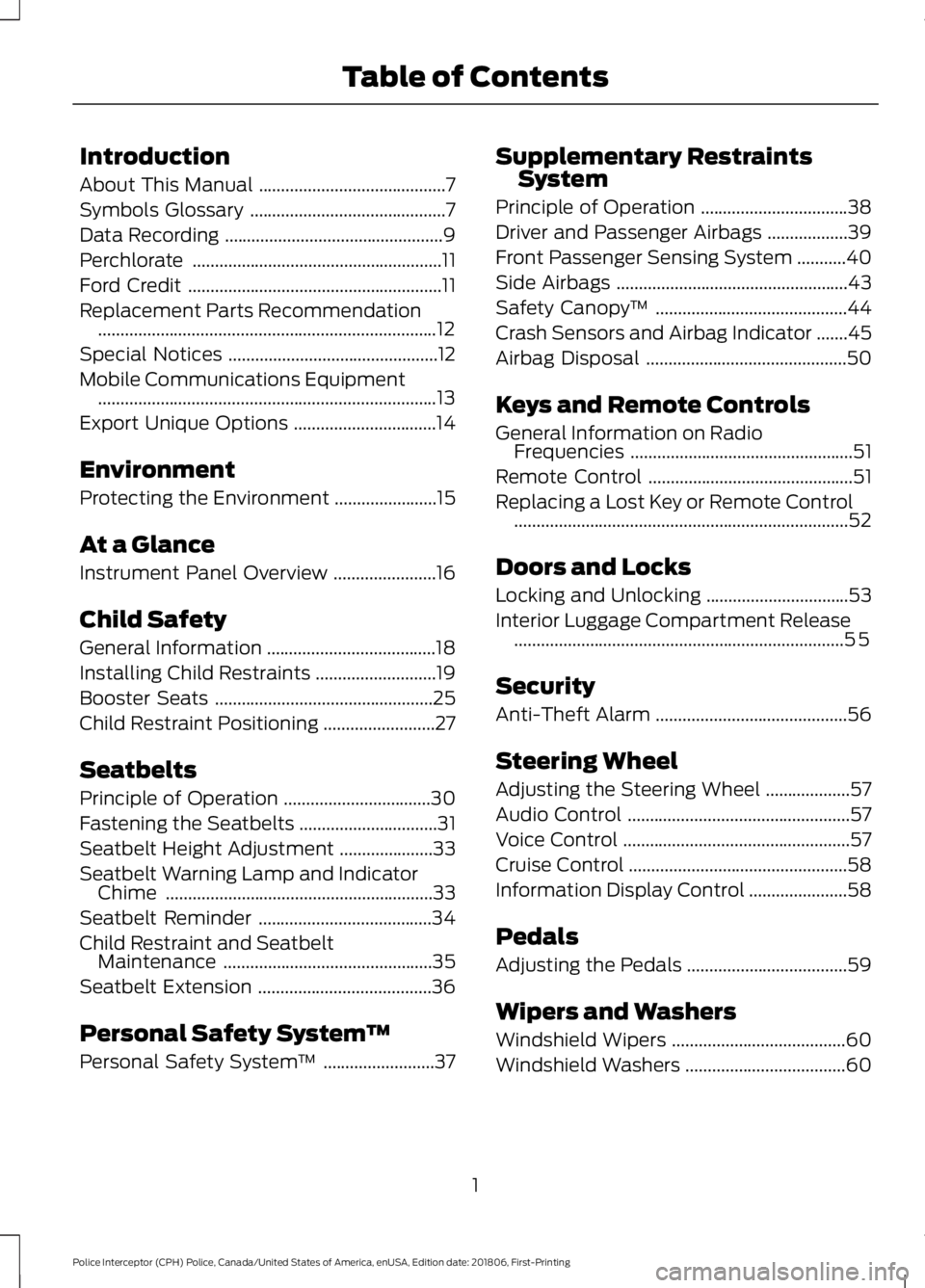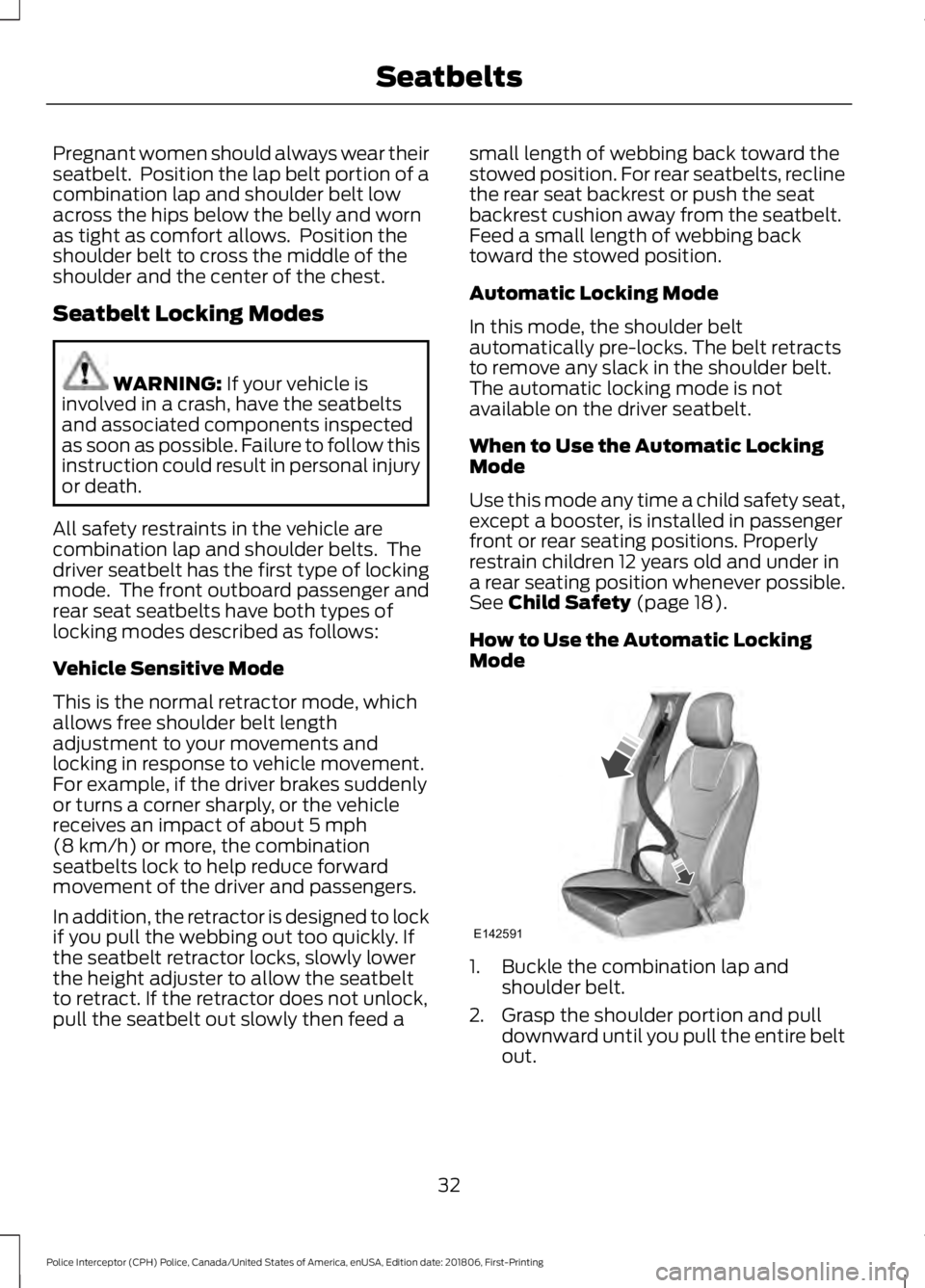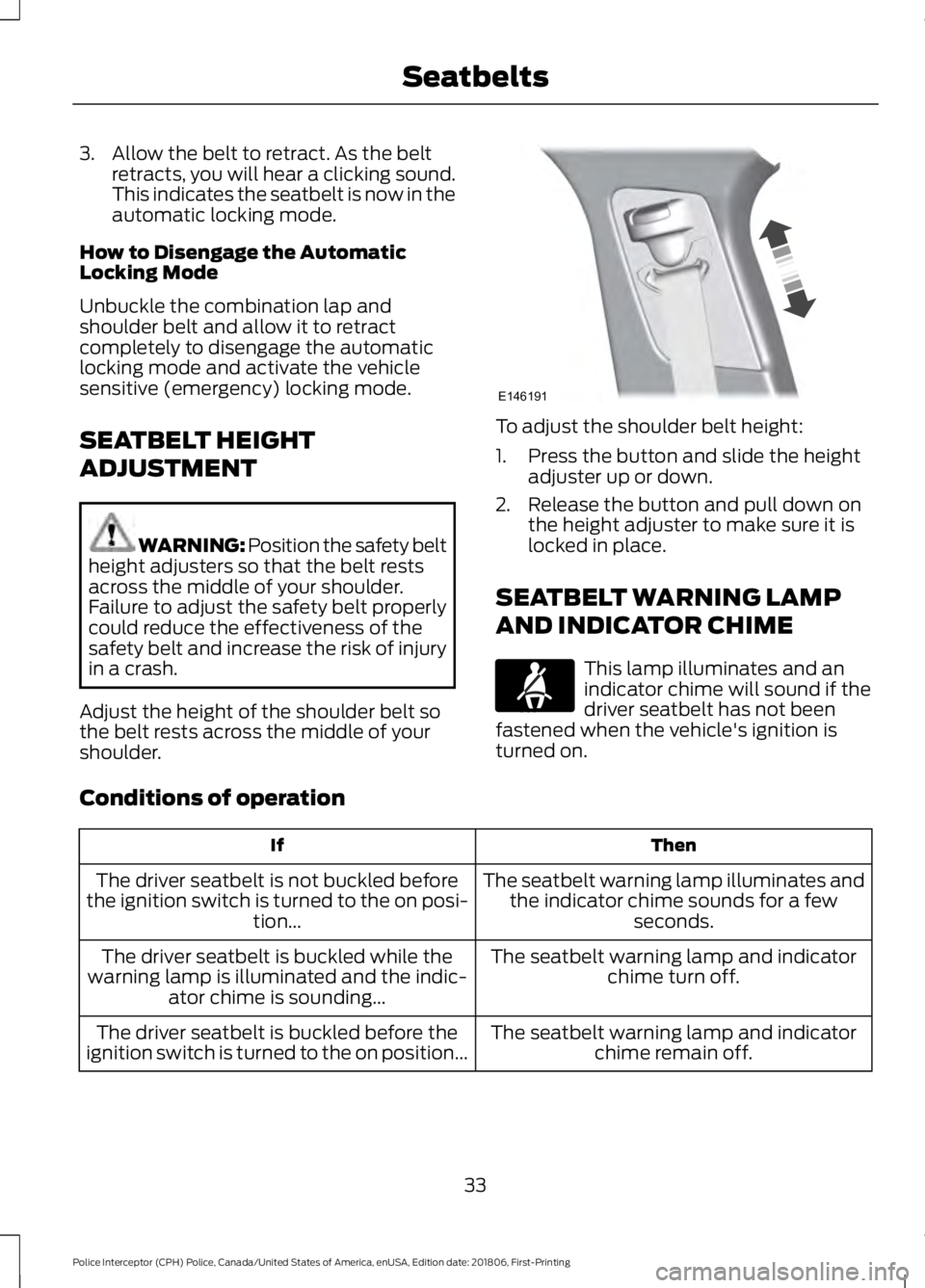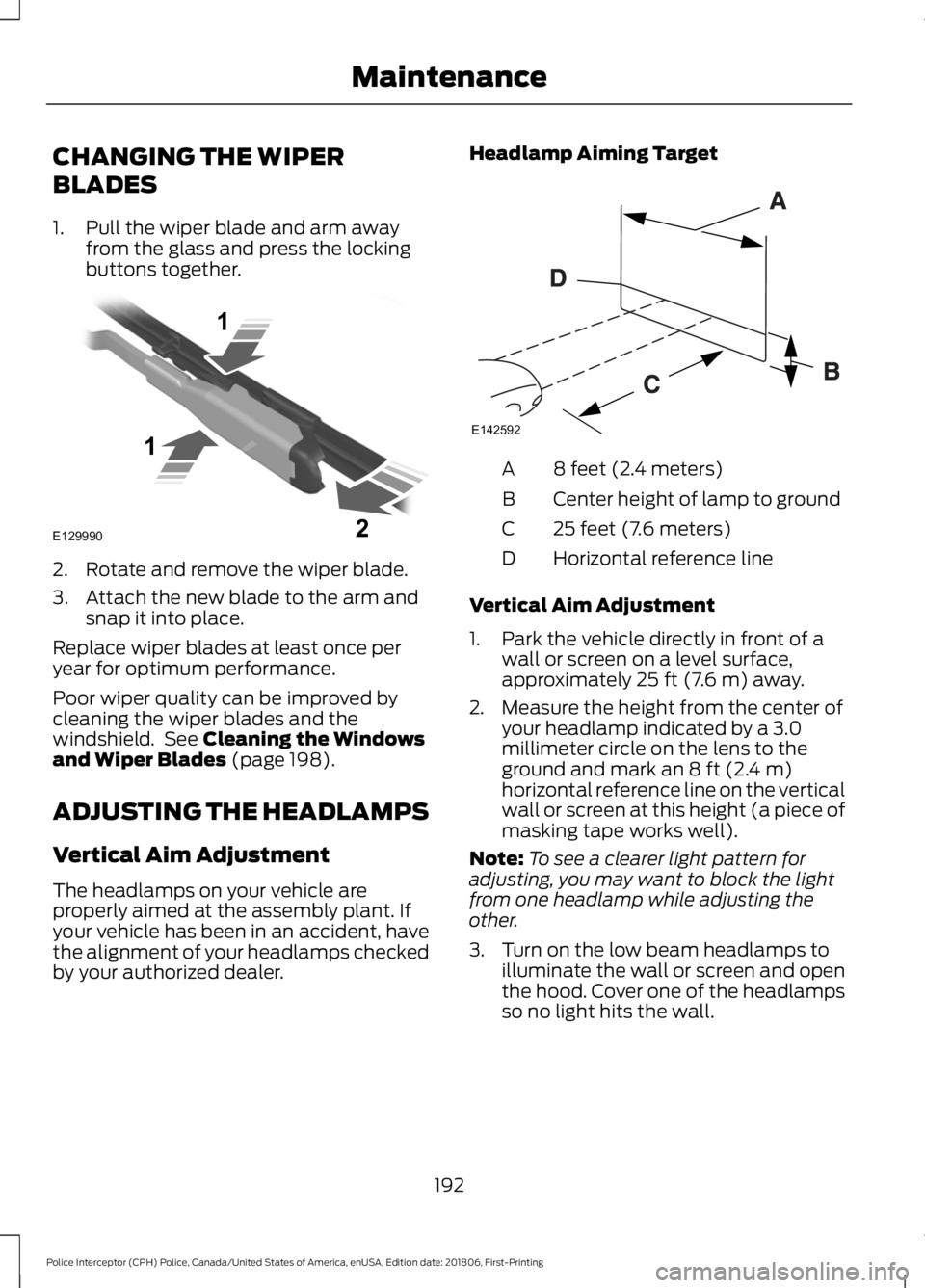2019 FORD POLICE INTERCEPTOR height adjustment
[x] Cancel search: height adjustmentPage 4 of 370

Introduction
About This Manual
..........................................7
Symbols Glossary ............................................
7
Data Recording .................................................
9
Perchlorate ........................................................
11
Ford Credit .........................................................
11
Replacement Parts Recommendation ........................................................................\
....
12
Special Notices ...............................................
12
Mobile Communications Equipment ........................................................................\
....
13
Export Unique Options ................................
14
Environment
Protecting the Environment .......................
15
At a Glance
Instrument Panel Overview .......................
16
Child Safety
General Information ......................................
18
Installing Child Restraints ...........................
19
Booster Seats .................................................
25
Child Restraint Positioning .........................
27
Seatbelts
Principle of Operation .................................
30
Fastening the Seatbelts ...............................
31
Seatbelt Height Adjustment .....................
33
Seatbelt Warning Lamp and Indicator Chime ............................................................
33
Seatbelt Reminder .......................................
34
Child Restraint and Seatbelt Maintenance ...............................................
35
Seatbelt Extension .......................................
36
Personal Safety System ™
Personal Safety System ™.........................
37 Supplementary Restraints
System
Principle of Operation .................................
38
Driver and Passenger Airbags ..................
39
Front Passenger Sensing System ...........
40
Side Airbags ....................................................
43
Safety Canopy ™...........................................
44
Crash Sensors and Airbag Indicator .......
45
Airbag Disposal .............................................
50
Keys and Remote Controls
General Information on Radio Frequencies ..................................................
51
Remote Control ..............................................
51
Replacing a Lost Key or Remote Control ........................................................................\
...
52
Doors and Locks
Locking and Unlocking ................................
53
Interior Luggage Compartment Release ........................................................................\
..
55
Security
Anti-Theft Alarm ...........................................
56
Steering Wheel
Adjusting the Steering Wheel ...................
57
Audio Control ..................................................
57
Voice Control ...................................................
57
Cruise Control .................................................
58
Information Display Control ......................
58
Pedals
Adjusting the Pedals ....................................
59
Wipers and Washers
Windshield Wipers .......................................
60
Windshield Washers ....................................
60
1
Police Interceptor (CPH) Police, Canada/United States of America, enUSA, Edition date: 201806, First-Printing Table of Contents
Page 35 of 370

Pregnant women should always wear their
seatbelt. Position the lap belt portion of a
combination lap and shoulder belt low
across the hips below the belly and worn
as tight as comfort allows. Position the
shoulder belt to cross the middle of the
shoulder and the center of the chest.
Seatbelt Locking Modes
WARNING: If your vehicle is
involved in a crash, have the seatbelts
and associated components inspected
as soon as possible. Failure to follow this
instruction could result in personal injury
or death.
All safety restraints in the vehicle are
combination lap and shoulder belts. The
driver seatbelt has the first type of locking
mode. The front outboard passenger and
rear seat seatbelts have both types of
locking modes described as follows:
Vehicle Sensitive Mode
This is the normal retractor mode, which
allows free shoulder belt length
adjustment to your movements and
locking in response to vehicle movement.
For example, if the driver brakes suddenly
or turns a corner sharply, or the vehicle
receives an impact of about
5 mph
(8 km/h) or more, the combination
seatbelts lock to help reduce forward
movement of the driver and passengers.
In addition, the retractor is designed to lock
if you pull the webbing out too quickly. If
the seatbelt retractor locks, slowly lower
the height adjuster to allow the seatbelt
to retract. If the retractor does not unlock,
pull the seatbelt out slowly then feed a small length of webbing back toward the
stowed position. For rear seatbelts, recline
the rear seat backrest or push the seat
backrest cushion away from the seatbelt.
Feed a small length of webbing back
toward the stowed position.
Automatic Locking Mode
In this mode, the shoulder belt
automatically pre-locks. The belt retracts
to remove any slack in the shoulder belt.
The automatic locking mode is not
available on the driver seatbelt.
When to Use the Automatic Locking
Mode
Use this mode any time a child safety seat,
except a booster, is installed in passenger
front or rear seating positions. Properly
restrain children 12 years old and under in
a rear seating position whenever possible.
See
Child Safety (page 18).
How to Use the Automatic Locking
Mode 1. Buckle the combination lap and
shoulder belt.
2. Grasp the shoulder portion and pull downward until you pull the entire belt
out.
32
Police Interceptor (CPH) Police, Canada/United States of America, enUSA, Edition date: 201806, First-Printing SeatbeltsE142591
Page 36 of 370

3. Allow the belt to retract. As the belt
retracts, you will hear a clicking sound.
This indicates the seatbelt is now in the
automatic locking mode.
How to Disengage the Automatic
Locking Mode
Unbuckle the combination lap and
shoulder belt and allow it to retract
completely to disengage the automatic
locking mode and activate the vehicle
sensitive (emergency) locking mode.
SEATBELT HEIGHT
ADJUSTMENT WARNING: Position the safety belt
height adjusters so that the belt rests
across the middle of your shoulder.
Failure to adjust the safety belt properly
could reduce the effectiveness of the
safety belt and increase the risk of injury
in a crash.
Adjust the height of the shoulder belt so
the belt rests across the middle of your
shoulder. To adjust the shoulder belt height:
1. Press the button and slide the height
adjuster up or down.
2. Release the button and pull down on the height adjuster to make sure it is
locked in place.
SEATBELT WARNING LAMP
AND INDICATOR CHIME This lamp illuminates and an
indicator chime will sound if the
driver seatbelt has not been
fastened when the vehicle's ignition is
turned on.
Conditions of operation Then
If
The seatbelt warning lamp illuminates andthe indicator chime sounds for a few seconds.
The driver seatbelt is not buckled before
the ignition switch is turned to the on posi- tion...
The seatbelt warning lamp and indicatorchime turn off.
The driver seatbelt is buckled while the
warning lamp is illuminated and the indic- ator chime is sounding...
The seatbelt warning lamp and indicatorchime remain off.
The driver seatbelt is buckled before the
ignition switch is turned to the on position...
33
Police Interceptor (CPH) Police, Canada/United States of America, enUSA, Edition date: 201806, First-Printing SeatbeltsE146191 E71880
Page 195 of 370

CHANGING THE WIPER
BLADES
1. Pull the wiper blade and arm away
from the glass and press the locking
buttons together. 2. Rotate and remove the wiper blade.
3. Attach the new blade to the arm and
snap it into place.
Replace wiper blades at least once per
year for optimum performance.
Poor wiper quality can be improved by
cleaning the wiper blades and the
windshield. See Cleaning the Windows
and Wiper Blades (page 198).
ADJUSTING THE HEADLAMPS
Vertical Aim Adjustment
The headlamps on your vehicle are
properly aimed at the assembly plant. If
your vehicle has been in an accident, have
the alignment of your headlamps checked
by your authorized dealer. Headlamp Aiming Target
8 feet (2.4 meters)
A
Center height of lamp to ground
B
25 feet (7.6 meters)
C
Horizontal reference line
D
Vertical Aim Adjustment
1. Park the vehicle directly in front of a wall or screen on a level surface,
approximately
25 ft (7.6 m) away.
2. Measure the height from the center of your headlamp indicated by a 3.0
millimeter circle on the lens to the
ground and mark an
8 ft (2.4 m)
horizontal reference line on the vertical
wall or screen at this height (a piece of
masking tape works well).
Note: To see a clearer light pattern for
adjusting, you may want to block the light
from one headlamp while adjusting the
other.
3. Turn on the low beam headlamps to illuminate the wall or screen and open
the hood. Cover one of the headlamps
so no light hits the wall.
192
Police Interceptor (CPH) Police, Canada/United States of America, enUSA, Edition date: 201806, First-Printing MaintenanceE129990
1
1 2 E142592
Page 368 of 370

Roadside Assistance...................................152
Vehicles Sold in Canada: Getting Roadside
Assistance........................................................ 153
Vehicles Sold in the United States: Getting Roadside Assistance.................................... 152
Vehicles Sold in the United States: Using Roadside Assistance.................................... 152
Roadside Emergencies...............................152
Running-In See: Breaking-In.................................................. 149
Running Out of Fuel......................................99 Adding Fuel From a Portable Fuel
Container..........................................................100
Filling a Portable Fuel Container.................. 100
S
Safety Canopy ™
............................................44
Safety Precautions........................................97
Scheduled Maintenance Record...........307
Scheduled Maintenance..........................299
Seatbelt Extension........................................36
Seatbelt Height Adjustment
......................33
Seatbelt Reminder........................................34
Belt-Minder™........................................................ 34
Seatbelts...........................................................30 Principle of Operation........................................ 30
Seatbelt Warning Lamp and Indicator Chime...............................................................33
Conditions of operation..................................... 33
Seats...................................................................86
Security..............................................................56
Side Airbags
.....................................................43
Sitting in the Correct Position...................86
Snow Chains See: Using Snow Chains.................................. 218
Spare Wheel See: Changing a Road Wheel........................ 222
Special Notices................................................12 My Fleet Management........................................ 13
New Vehicle Limited Warranty......................... 12
On-board Diagnostics (OBD-II)....................... 13
Special Instructions.............................................. 12
Special Operating Conditions Scheduled Maintenance..............................................305
Engine Idle Hour Meter.................................... 306
Exceptions............................................................ 307Speed Control
See: Cruise Control............................................ 130
Stability Control............................................124 Principle of Operation....................................... 124
Starter Switch See: Ignition Switch............................................. 92
Starting a Gasoline Engine.........................93 Cold Weather Starting - Flex Fuel
Vehicles............................................................... 93
Failure to Start....................................................... 93
Guarding Against Exhaust Fumes.................94
Important Ventilating Information................94
Stopping the Engine When Your Vehicle is Moving................................................................. 94
Stopping the Engine When Your Vehicle is Stationary.......................................................... 94
Starting and Stopping the Engine...........92 General Information............................................ 92
Steering.............................................................137 Electric Power Steering..................................... 137
Steering Wheel................................................57
Storage Compartments
...............................91
Sun Visors.........................................................69
Slide-on-rod.......................................................... 69
Supplementary Restraints System.........38 Principle of Operation........................................ 38
Symbols Glossary
.............................................7
SYNC™ Applications and Services.......275 911 Assist................................................................ 275
SYNC™ AppLink ™
......................................277
SYNC Mobile Apps............................................. 277
SYNC™............................................................257 General Information.......................................... 257
SYNC™ Troubleshooting
.........................288
T
Technical Specifications See: Capacities and Specifications............228
The Better Business Bureau (BBB) Auto Line Program (U.S. Only)........................159
Tire Care..........................................................204 Glossary of Tire Terminology........................ 205
Information About Uniform Tire Quality Grading............................................................. 204
Information Contained on the Tire Sidewall........................................................... 206
Police Wheels and Tires................................... 217
365
Police Interceptor (CPH) Police, Canada/United States of America, enUSA, Edition date: 201806, First-Printing Index